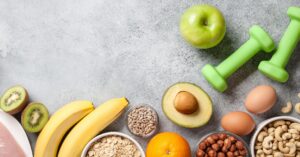
Proper nutrition is essential for building muscle and improving physical fitness. Understanding daily caloric needs is crucial in achieving fitness goals. It is recommended to consume 20 calories per pound of body weight per day to gain muscle. Dividing macronutrients by the number of meals consumed per day can help ensure that the body is receiving the necessary nutrients to support muscle growth. Consuming an appropriate amount of calories and nutrients, particularly protein, is crucial for supporting muscle growth and physical fitness.
Protein is a vital nutrient for building muscle. Eating a balanced diet that includes protein, carbohydrates, and fat plays a significant role in supporting strength building. Current guidelines suggest that people who wish to build muscle should consume a higher amount of protein. The process of muscle protein synthesis is stimulated by strength training and consuming protein. Maximizing muscle building requires increasing the rate of protein deposition while minimizing the rate of protein breakdown. Thus, incorporating a sufficient amount of protein into one’s diet is essential for building muscle and improving physical fitness.
Adequate hydration and nutrient timing are also crucial for building muscle and improving physical fitness. Drinking enough water before, during, and after exercise is essential to prevent dehydration and support muscle function. Consuming carbohydrates and protein after exercise can help replenish glycogen stores and support muscle recovery. Nutrient timing, or the strategic planning and consumption of whole foods, fortified foods, and dietary supplements, can also play a role in optimizing muscle growth and recovery. Thus, incorporating proper hydration and nutrient timing into one’s fitness routine can support muscle growth and improve physical fitness.
Effective strength training exercises for building muscle
Compound exercises are an effective way to build muscle and improve overall physical fitness. These exercises involve multiple muscle groups and allow for greater resistance to be added, leading to increased muscle development. Examples of compound exercises include squats, deadlifts, bench presses, and pull-ups. The eight main compound exercises that are essential for building muscle and strength are the dip, barbell deadlift, squat, bench step-ups, bent-over row, pull-up, military press, and shrug. Incorporating these exercises into a strength training routine can lead to significant muscle gains and improved overall physical fitness.
Isolation exercises are another effective way to target specific muscle groups and promote muscle growth. These exercises focus on one particular muscle group and can be used to supplement compound exercises. Examples of isolation exercises include calf raises, leg extensions, hamstring curls, and bicep curls. While compound exercises work multiple muscle groups at a time, isolation exercises seek to stimulate only one muscle group, making them a useful addition to any strength training routine. By incorporating isolation exercises into a workout routine, individuals can increase their training volume for a particular muscle group, leading to greater muscle development and improved physical fitness.
In addition to incorporating compound and isolation exercises into a strength training routine, it is important to use proper form and gradually increase resistance to promote progressive overload. Progressive overload involves gradually increasing the weight, frequency, or number of repetitions in a strength training routine. This can be achieved by using techniques such as super sets or increasing the weight lifted. By using progressive overload, individuals can promote the development of muscle mass and strength, leading to improved physical fitness.
Other methods for improving physical fitness and supporting muscle growth
In addition to weightlifting, incorporating cardiovascular exercise into a fitness routine is essential for improving endurance and overall health. Cardiovascular exercise, such as running, cycling, or swimming, can help strengthen the heart muscle and improve blood flow throughout the body. Regular exercise has also been shown to boost energy levels by improving sleep and increasing blood flow. To improve cardiovascular endurance, individuals can use lighter weights and higher rep counts to gradually increase endurance over time.
Recovery and rest days are also crucial for muscle repair and growth. Designing a workout program that alternates muscle groups in different workouts can increase the recovery period between sessions. Rest and recovery allow muscles to heal and prevent injuries, making them an important part of any workout plan. To optimize muscle recovery, individuals can hydrate consistently, stretch regularly, replenish electrolytes, and consume protein-rich foods. In some cases, reducing training load or volume, ceasing exercise temporarily, or changing the focus of workouts may be necessary to prevent overtraining and promote muscle recovery.
Supplementation can also support optimal muscle growth and overall health. Resistance training, such as weightlifting, is the most effective way to promote muscle growth. However, incorporating supplements such as protein powder, creatine, and amino acids can also aid in muscle recovery and growth. It’s important to note that supplements should not be relied upon as the sole means of achieving muscle growth, but rather used in conjunction with a well-rounded workout routine and proper nutrition. Ultimately, consistent and challenging resistance training, coupled with proper rest and nutrition, is the most effective way to build muscle and improve physical fitness.







